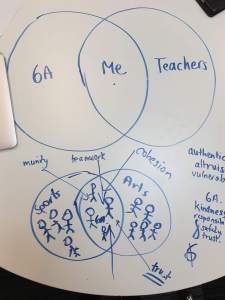There’s an issue in my classroom. It doesn’t quite qualify as an elephant in the room because we have had many a conversation about it. The students brought it to my attention a while ago and we’ve been ‘dealing’ with it ever since.
Here’s the deal. The students have managed to divide themselves into two academic camps. They are identifying as either ‘sporty’ or ‘arty’. I suspect that there are a few quietly spoken individuals who don’t see themselves as completely one or the other. But the need to sort identities at the perilous age of twelve has our class at crossroads.
Why is this such a problem, I hear you ask? It seems that we have become a little defensive of our particular preference. To the point of disrupting lessons of the opposite persuasion. If I’m an ‘arts’ kid, I might need to be dragged reluctantly into the game of football. If I’m a ‘sporty’ kid, I’m going to paint my friend’s face with the paint instead of the white paper in front of me. You can see how this dynamic might lead to some tension in the class as we defend our camp and become increasingly frustrated at the specialist teachers’ attempts to manage the disruption or reluctance.
“It’s all well and good for you to complain about us mucking up in art and music, but you barely even try when we’re playing footy.”
“Well, you waste all of the teacher’s time by mucking around during art and music!”
As the classroom teacher, I’m on the receiving end of specialist teacher frustration about the children’s behaviour. I’m understanding of this situation – it must be frustrating. But I also feel the urge to defend each learner. You just need to get to know them…it takes a while to set up routines…they are good kids etc. etc.”
So I decided to take some time to address the issue directly.
I started by drawing this on the table.

I started with the Venn diagram at the bottom. We spoke about the tension that someone feels being in the middle.
What causes this particular type of tension?
Having recently read Dr Helen Street’s book, Contextual Wellbeing, I’m reminded that wellbeing actually exists in the spaces and relationships between us.
Students identified that tension comes from feeling torn between groups. But what might also exist at the intersection of two groups could be possibilities like teamwork, community, trust, and cohesion. Trust, it seems, is key. This was the feeling of my students.
I asked, “What does it mean to have someone’s back?”
The consensus was that the person can trust that you will act in their best interests. Again, trust.
I asked students to consider: “How many people in this class have your backs? Please count silently whilst looking around the room.”
“Now, whose back do you have? Please count again.”
We recorded the numbers without names. But the discrepancy between the two numbers was concerning. Most students felt that fewer people had their backs than they had theirs. One student suggested that just because someone is your friend, it doesn’t mean you trust that they have your back. Back to trust again. One student even disclosed that more people have her back than she has theirs. How is this possible??
So I asked why Trust was a problem. We are more than halfway through the school year and we should be ok with each other by now, surely.
“Because we don’t really know each other,” replied one brave soul.
These children have mostly been at school together for over six years. But in some ways, I suppose as they grow and change, they don’t know each other as they feel they should.
So where do we go with trust? How do we build trust? How do we get to know each other? How do we feel safe to say what we feel and show a little vulnerability?
It is going to be a mini-inquiry. We have our first volunteers who have offered to run a circle time focused on building trust. We will evaluate and reflect on the session with trust as the measure of success. Small increments of developing trust.
